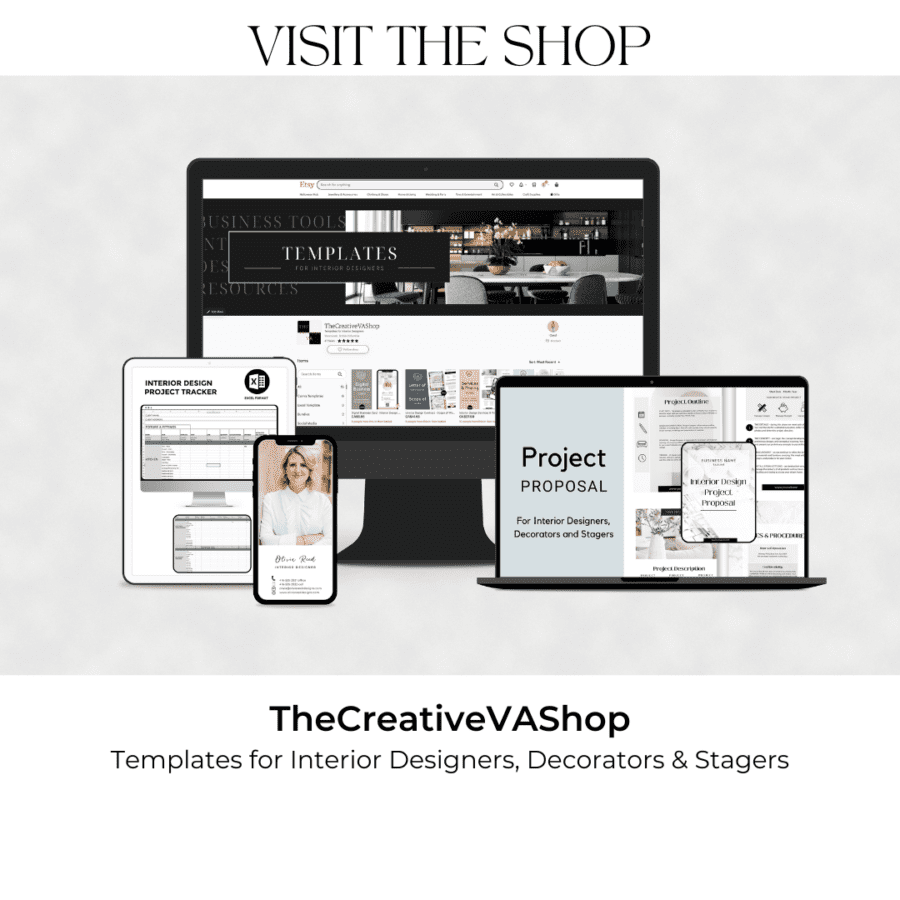
On a scale of 1 to 10 how would you rate your design business in terms of the back end processes? If you’re feeling you’re a 3 or 4 then you’re in good company.
I started asking this question at the beginning of all my coaching calls and 3-4 is where about 95% of my clients land.
The mistakes you’re making in business are the very same mistakes being made by the designer you look at on social media and think she has her sh*t together. How can I say that so confidently? Because those are the designers I’m speaking to.
On the outside, a lot of people look like they’ve got it together but as an industry we’re lost. This is my perspective on why:
- There’s not enough education about how to run a business. Design, yes. Business no.
- We don’t have a passion for the business/operations aspects of our business.
- We are overworked with client work and short on time for everything else.
- Social media is a 2nd full-time job (next to design) and we’re burned out.
- We don’t have help and are trying to do it all alone.
First, before we begin I want to say that every mistake I point out below is also a mistake I have made in my own business. This is a judgement free zone because everything I share I’ve also experienced and dealt with through a lot of trial and error. The good news is that you can fix all of these things with some time and effort.
4 Big mistakes you’re making in your business
Reinventing the Wheel
Without a doubt this is the biggest mistake I see. Every new client you sign starts fresh and you begin the document creation process from the beginning. This is the easiest issue to fix but it requires time which I know you’re super short on.
What if I told you that you could save 5 hours with every new client just by creating some templates? Just imagine what you can do with those extra hours. Here are the easy fixes for this one.
Easy fixes
- Create a Services & Pricing Guide that is sent to inquiring prospects. Extra points if you upload it to your email service provider. This is a double benefit for your business – first you provide important information for a prospective client but you also create a solid email list which is a huge advantage in the marketing game.
If you’re about to say “I’d rather get on a call with them” I’m going to encourage you to rethink that philosophy. When someone sees your pricing and doesn’t follow up, good. If they can’t afford you, a phone call will not convince them that they can. And save yourself the future heartache of the constant money battle you’ll have if you do convince them. They’re not your dream client so let’s move on.
- Create a Project Proposal template to send to each new client. The only updates you’ll add are the client’s personal information as well as your proposed estimate for the project.
- Create a Client Questionnaire that does your work for you. Send it to every new client and have them fill it in or use it in your first meeting.
- Create a Welcome Guide template that outlines your important business information. You can add what suits you but outlining your process, your policies (hello weekend texting clients) and what your clients can expect.
We haven’t even got past the onboarding phase and you can see how much time this could save. As well, it’s the elimination of mental chatter that can often be the biggest benefit.
No Outlined Process
I see you with that puzzled look on your face. You’re not even sure what I mean, amiright? Again, I know this because I see the puzzled look on my clients’ faces.
This is not your design process that I’m referring to. It’s the process of taking a client from Inquiry Phase to Offboarding Phase. Every project is different and unique but your client process should always remain the same.
This works in conjunction with the first point of reinventing the wheel. I know you think you have no process but if you were to spend a couple of hours you could write down everything you’d see your own process emerge.
WANT SOME SUGGESTIONS FOR HOW TO IMPROVE YOUR PROCESSES FROM BEGINNING TO END? READ THIS POST
No Time Carved Out for Your Back Office Work
I hear you loud and strong on this one. Your client work is taking up the entirety of your 40-hour work week. And who is going to carve out time for a chore they hate?
My suggestion is to tackle it as tiny little pieces as opposed to having to commit to evenings and weekends working on the whole.
For example, if you know your entire client facing process needs to be revamped set up a calendar of tasks:
- Week 1 – Create a Services & Pricing Guide template in Canva. Can you do this while you watch RHOBH? Yes just do the last round of proofreading without the distraction.
- Week 2 – Create canned emails. There are 6 or 7 emails that you’re creating from scratch. If you were to create all of these and set them up in Gmail you’d get back a couple of hours every week. Added bonus, you’d feel a tiny bit more in control.
So what I’m saying is that you don’t have to commit to tackling the entirety of the office revamp in a week or a month. It’s just about being consistent and doing one small thing every week.
Inconsistent Energy Throughout the Project
This is the one that’s causing the most problems between you and your clients. When we sign a new client we’re excited and the honeymoon phase is on.
Once the project starts moving we run into all the problems – clients are stressed, unexpected delays start happening, problems appear on the site, etc.
Now you’re putting out fires and you start to pull back from the client just a little bit because you don’t want to deal with their frustration.
Who wants to walk into the fire? Nobody, so I get it but this is making you feel less in control. The solution is (sorry for being a broken record) tightening up your processes. Here’s how it works:
- Client project begins beautifully and they love your vision.
- Walls open up and mice have chewed up the old electrical. Need more $.
- Client feels stressed and wants to know why you didn’t anticipate this.
- You need to resource materials to fit this into the budget.
- The clients are calling, the contractor is calling and you’re not finished the design.
- You avoid the client (just for today) and they become more frustrated.
Instead, what if you did this:
- Client project begins beautifully and they love your vision.
- Walls open up and mice have chewed up the old electrical. Need more $.
- Client is stressed and asks why you didn’t anticipate this.
- You sit down with your client and explain that this is unavoidable and not something you could have anticipated. But you have a contingency and this will come from that fund.
- The clients are calling for updates and you let them know you are on it and will be in touch on Friday via your end-of-week wrap-up email. They’ll get all the info they need.
This is just one example of how you can manage the project and your clients with your full enthusiasm and energy. Become so prepared that these normal anomalies that nothing sets you off course.
Need some help creating templates for your design business? Visit my Etsy shop for all your template needs
